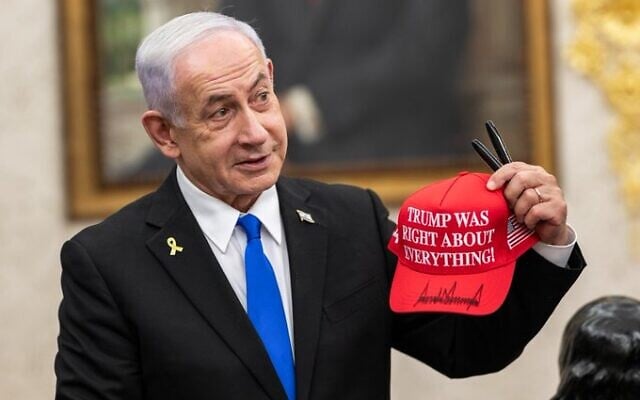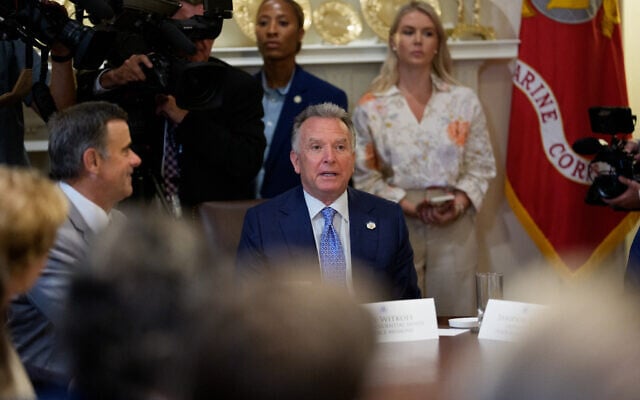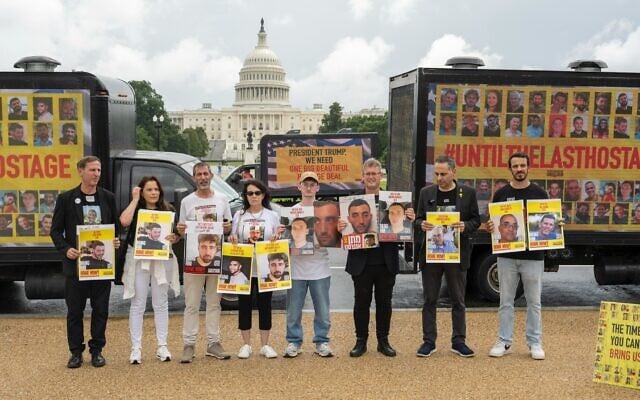



This Editor’s Note was sent out earlier Wednesday in ToI’s weekly update email to members of the Times of Israel Community. To receive these Editor’s Notes as they’re released, join the ToI Community here.
US President Donald Trump wants to end the war in Gaza as soon as possible. “We’ve got to get that solved,” he told his cabinet on Tuesday. A deal is close at hand, he indicated. Both Israel and Hamas want it, he said.
Added the president’s most trusted envoy, Steve Witkoff: “We think it will lead to a lasting peace in Gaza.”
Prime Minister Benjamin Netanyahu was hurriedly called back to the White House, a day after he, his team and his wife had dinner there. He left more than an hour later, with both he and Trump, uncharacteristically, eschewing meetings with the media before, during or after their talk, at which Vice President JD Vance was also present.
Happy, smiling pictures were released, however, including one showing Netanyahu holding a baseball cap emblazoned, “Trump was right about everything!”
Plainly, things are cooking.
Netanyahu has not been prepared to back a one-time deal to end the war in exchange for all the hostages because he fears, he says, that the US and international community will not permit Israel to resume fighting Hamas, when, as it inevitably will, it breaches the terms of any permanent ceasefire.
Witkoff helped finalize the last phased hostage-ceasefire deal, in January, but it collapsed in March because Netanyahu was not willing to negotiate substantively on ending the war. Thirty-eight soldiers, a police officer and a civilian Defense Ministry contractor have been killed in Gaza since then.
The redoubtable envoy says three of the four areas of dispute that have since prevented a new phased accord have been resolved in this week’s “proximity talks” in Doha. “We had four issues and now we’re down to one,” he said on Tuesday.
Curiously, however, many reports indicate that the one outstanding issue relates to the specifics of the IDF’s withdrawal in the course of the initial 60-day temporary truce period, during which 10 living and 18 slain hostages held in Gaza are to be freed.
Why is this curious? Because the specifics of where the IDF is deployed in those first 60 days would appear to be a relatively marginal issue, given that the ostensible goal of this new phased deal, just like the last one, is to secure a permanent ceasefire in which all of the hostages would be freed, the IDF would fully withdraw from Gaza and the war would be over.
If the only unresolved issue is the matter of the IDF’s interim deployment, that would suggest that Hamas, battered and much depleted by 21 months of war, knows that this deal, too, will not in fact lead to a permanent end of hostilities.
The last reliable published text of the so-called Witkoff proposal stated that if “negotiations on the arrangement for a permanent ceasefire are not concluded” within the first 60 days, “the temporary ceasefire may be extended under conditions and for a duration to be agreed upon by the parties so long as the parties are negotiating in good faith.” To date, Hamas had been demanding that the phrase “in good faith” be deleted, assessing that Netanyahu would exploit that clause to resume the campaign to destroy its military and governance capacities, and it had been seeking reliable guarantees, from the US and the UN Security Council, that the deal will indeed bring the war to an end.
Yet shortly before returning to the White House, Netanyahu held a lengthy session with reporters on Capitol Hill in which he repeated, very deliberately, several times, that Israel remains absolutely and completely “determined to complete all the goals of the war in Gaza: to free all our hostages; to bring about the destruction of Hamas’s military and governance capacities, and to ensure that Gaza will no longer be a threat to Israel.” He stressed, over and over again: “That means no Hamas. This must be understood.”
He further specified that “no Hamas” means “Hamas needs to put down its weapons, to be dismantled, and Gaza demilitarized. We have the power [to achieve this]. I won’t give up on this. And I won’t give up on the hostages.”
So Trump wants to end the war. Witkoff believes the deal under discussion can bring lasting peace. Netanyahu insists he’s not compromising on the declared goal of utterly destroying Hamas, as a fundamental requirement for long-term security and stability. And Hamas is reportedly fixated on the location of the IDF for the first 60 days of the agreement?
Presumably, we’re missing something here, something wider and still more dramatic. Because as things stand, Hamas will be signing on to an arrangement carefully crafted to ultimately enable its elimination. It knows the deal will not extend beyond the first 60 days because, this time around, just as in March, Netanyahu will not agree to end the war. It will thus use the 60-day temporary ceasefire period to regroup, recruit and rearm. And the war will then resume, with 22 hostages, at least 10 of them alive, still held in captivity.
“We are fighting a very cruel, cynical enemy and we don’t need to tell it our plans,” the prime minister noted during that Capitol Hill appearance on Tuesday. Twenty-one months into the war, achieving all of Israel’s goals, he added cryptically, “entails a certain strategy, which I will not detail here.”
Let’s hope the Israeli and US leaderships have found one. We’ll know soon enough.



